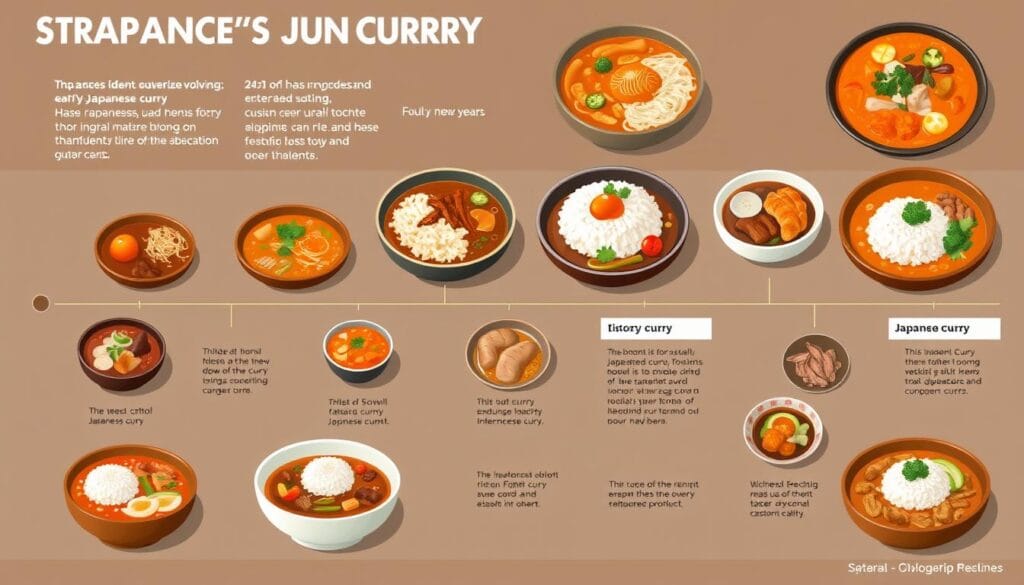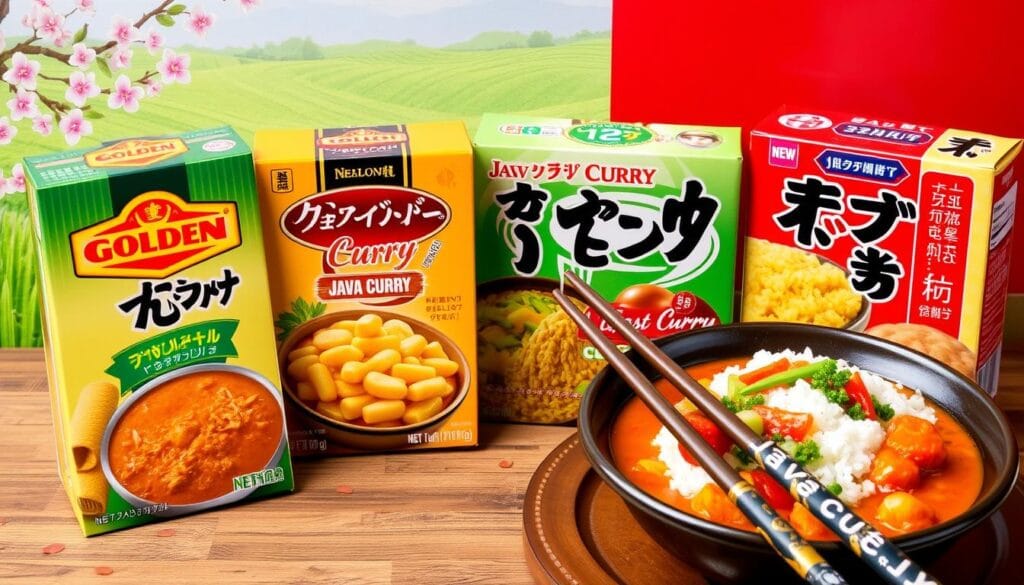Japanese curry rice, or kare raisu, is a favorite comfort food loved by many. It’s a special dish that takes traditional Indian curry and makes it uniquely Japanese. S&B Golden Curry is a key player in this tasty tradition, making it easy for everyone to enjoy.
Unlike spicy Indian curry, Japanese curry rice is sweeter and thicker, like a stew. S&B Golden Curry is known for its authentic Japanese curry taste. It brings the dish’s rich flavors to kitchens everywhere.
If you’re new to cooking or already love curry, this guide is for you. It covers everything about Japanese curry, from its history to how to make it today.
Key Takeaways
- Japanese curry is a unique comfort food with a milder flavor profile
- S&B Golden Curry is a popular and authentic brand outside Japan
- Kare raisu differs significantly from traditional Indian curry
- Multiple spice levels are available to suit different preferences
- The dish combines rich flavors with simple, hearty ingredients
The History and Evolution of Japanese Curry
Curry’s journey to Japan is a fascinating tale of culinary transformation. It started in India, influenced by British colonialism, and found a unique home in Japanese cuisine. This journey shows a remarkable cultural exchange that reshaped food traditions.

From India to Japan: A Culinary Journey
The curry origins trace back to international culinary exchange. British naval traders introduced curry to Japan in the late 19th century. They brought a modified version of the original Indian recipe. This import would soon transform in Japanese kitchens.
- Initial introduction by British naval traders
- Adaptation of British curry recipes
- Localization of flavor profiles
The Meiji Period Influence
The Meiji period saw a significant change in Japanese cuisine. The government’s push for Western-style modernization coincided with curry’s introduction. By 1963, the launch of Vermont Curry was a key moment in Japanese culinary history.
“Curry became more than a dish—it became a cultural phenomenon in Japan.”
Modern Japanese Curry Culture
Today, Japanese curry is a national staple. Its impact is evident in statistics:
| Year | Curry Production | Market Significance |
|---|---|---|
| 2007 | 82.7 billion yen (instant curry roux) | Largest vacuum-sealed food category |
| 2013 | 7,570 tons (curry powder) | 91,105 tons (ready-made sauces) |
Restaurants like Coco Ichibanya have made Japanese curry popular worldwide. The dish continues to evolve, showing Japan’s innovative spirit in the kitchen.
Understanding Golden Curry and Popular Brands
Japanese curry has become a favorite dish, with S&B Golden Curry at the top. Since 1966, it has changed home cooking in Japan and worldwide. People in Japan eat curry about 80 times a year, showing its big role in culture.

Exploring curry roux brands opens up a world of tastes. Vermont Curry is sweet, while Java Curry is spicy. S&B Golden Curry has a mix of spicy, sweet, and savory flavors.
Popular Curry Roux Brands Breakdown
- S&B Golden Curry: The original Japanese curry pioneer
- Vermont Curry: Known for its mild, sweet flavor
- Java Curry: Delivers a more intense spicy experience
Japanese cooks like to mix different curry roux brands for new tastes. S&B offers various heat levels, from mild to extra hot. This lets you make your dish just right.
“Curry is more than just a meal in Japan – it’s a cultural expression of flavor and creativity.” – Japanese Culinary Expert
Interesting Curry Roux Facts
- S&B was the first to produce Japanese curry powder in 1923
- Golden Curry offers plant-based sauce options
- Traditional curry roux contains a blend of spices like chili pepper, garlic, and mustard
If you love curry or want to try new things, learning about these brands will help. It will make your Japanese cooking better and open up a world of tasty options.
Essential Ingredients for Perfect Japanese Curry
To make a real Japanese curry, you need to know its special ingredients. Start by picking the right curry ingredients. They should mix flavors and textures well.
Base Vegetables and Aromatics
A good Japanese curry starts with key vegetables. These add depth and sweetness. Here are the basics:
- Onions (caramelized for rich flavor)
- Carrots (adding natural sweetness)
- Potatoes (creating creamy texture)
- Garlic and ginger (providing aromatic complexity)
Protein Options
Choosing the right protein can change your curry. Japanese food has many protein choices:
| Meat Proteins | Seafood Options | Plant-Based Alternatives |
|---|---|---|
| Beef short ribs | Shrimp | Tofu |
| Chicken thighs | Squid | Tempeh |
| Pork shoulder | Mussels | Seitan |
Special Seasonings and Enhancers
Make your curry special with unique seasonings. These add complex flavors:
- Grated apple for subtle sweetness
- Honey for caramelization
- Chocolate for rich depth
- Soy sauce for umami
Pro tip: Try adding red wine or yogurt to make your curry unique.
The secret to Japanese curry is balancing flavors. Also, make it your own by adding what you like.
Spice Levels and Heat Classifications
Exploring Japanese curry spice levels is a fun journey. Unlike spicy dishes from the West, Japanese curry has a unique approach to heat. It suits many tastes.
The Japanese curry heat system has three main levels:
- Amakuchi: The mildest, great for those who like soft flavors
- Chuukara: A medium spice, balances flavor and heat well
- Karakuchi: The hottest, for those who love strong heat
S&B’s Golden Curry comes in four heat levels:
- Mild
- Medium Hot
- Hot
- Extra Hot
“Curry is not just about heat, it’s about experiencing a complex flavor journey.” – Japanese Curry Expert
Ingredients change with the spice level. Hotter curries have more chili pepper, black pepper, and spices like cumin. This makes them spicier.
When picking your curry, think about how spicy you like it. Trying different levels can find your ideal mix of flavor and heat.
Traditional Cooking Methods and Techniques
Japanese curry can be made in many ways, each with its own charm. You can choose from stovetop, microwave, or slow cooker methods. Each method adds its own twist to the dish.
Learning different ways to cook curry can make your meals more enjoyable. You can pick the method that fits your schedule and kitchen best. Let’s dive into the top techniques for making authentic Japanese curry.
Stovetop Preparation
The stovetop method is the most traditional way to make Japanese curry. Start by searing your meat to add flavor and get a nice brown color. Use a heavy pan and follow these steps:
- Heat oil and brown meat for 3-4 minutes
- Add chopped onions, carrots, and potatoes
- Pour 3 cups of water per 4 curry sauce bricks
- Simmer for 45 minutes
- Add curry roux and additional seasonings
- Cook for an additional 10-15 minutes
Microwave Method
The microwave method is quick and easy, yet still delicious. Mix all ingredients in a microwave-safe dish. Cook in short intervals, stirring between each.
“The microwave curry technique is perfect for busy home cooks seeking delicious meals with minimal preparation.”
Slow Cooker Variations
Slow cooker curry cooks meat slowly, making it tender and flavorful. It’s great for tougher cuts of meat that need low heat.
- Layer ingredients in the slow cooker
- Cook on low for 6-8 hours
- Add curry roux during the last hour
- Stir and let rest before serving
Pro tip: Try adding ketchup, oyster sauce, or grated apple to make your curry special.
Meat Selection and Preparation Guide
Choosing the right meat is key for a true Japanese curry taste. Your meat choice can change the flavor and texture of your dish.
Beef for curry is best with chuck roast. This cut is tender when slow-cooked. It makes the beef for curry so tender, it melts in your mouth.
“The secret to perfect Japanese curry lies in selecting the right cut of meat and preparing it with care.”
Recommended Meat Cuts
- Beef for curry: Chuck roast, short ribs, shoulder
- Pork in Japanese curry: Shoulder, loin, belly cuts
- Chicken curry: Thighs and drumsticks preferred
For a real Japanese curry, try these cooking tips:
- Sear meat before adding to curry for enhanced flavor
- Marinate in soy-based sauce with garlic and ginger
- Cook slowly to ensure maximum tenderness
| Meat Type | Best Cuts | Cooking Time |
|---|---|---|
| Beef | Chuck roast | 90-120 minutes |
| Pork | Shoulder | 60-90 minutes |
| Chicken | Thighs | 45-60 minutes |
Pro tip: Always brown your meat before adding it to the curry. This step adds rich, deep flavors that make your Japanese curry amazing.
Vegetable Combinations and Seasonal Variations
Making the perfect curry vegetables means knowing when to pick the best ingredients. By choosing the right veggies for each season, your curry can go from ordinary to extraordinary.
Japanese curry is great because you can use many different veggies. Each season offers a chance to make your curry taste better and be healthier.
Classic Vegetable Pairings
For a summer curry, you’ll want a mix of veggies that add texture and flavor:
- Onions (the base of most curries)
- Carrots (sweet and tasty)
- Potatoes (for a hearty feel)
Summer Vegetable Options
Summer is the time for fresh, juicy veggies in your curry. Try adding these:
- Grilled eggplant
- Tender okra
- Sweet pumpkin
- Zucchini
- Bell peppers
Winter Comfort Combinations
In the cold months, your curry can be a cozy, filling meal. Winter veggies might include:
- Root veggies
- Hearty squash
- Robust greens
- Dense mushrooms
“The magic of curry lies in its ability to transform simple vegetables into a memorable dining experience.”
Trying new veggie mixes keeps your curry exciting and healthy all year.
Secret Ingredients to Enhance Curry Flavor
Creating the perfect curry flavor is more than just using common ingredients. Chefs and home cooks have found special curry flavor enhancers. These ingredients turn a simple dish into a memorable meal.
Instant coffee is a surprising top secret curry ingredient, according to recent surveys. It adds a deep flavor that makes the curry even better. Just a small amount can dramatically change your dish’s taste.
“The magic of curry lies in its unexpected ingredients” – Japanese Culinary Experts
Top Secret Ingredients for Curry Flavor
- Instant Coffee (Most Popular Secret Ingredient)
- Worcestershire Sauce (“Sosu” in Japanese)
- Chocolate (Used by 36 respondents)
- Honey
Honey is a big game-changer in curry making. Studies show that 88% of people found their curry tasted better with honey. Also, 73% said the spice smell got stronger.
| Secret Ingredient | Flavor Impact | Popularity Ranking |
|---|---|---|
| Instant Coffee | High Depth | 1st Place |
| Worcestershire Sauce | Umami Enhancement | 2nd Place |
| Chocolate | Rich Complexity | 3rd Place |
Some people even use leftover jam and Calpis in their curry. This shows how creative home cooks can be with flavors.
Remember, trying new things is important when looking for curry flavor enhancers. Each secret ingredient adds its own special touch. This makes your curry truly yours.
Learn how to prepare Crockpot ground beef dishes and quick hamburger dinners effortlessly.
Rice and Alternative Serving Suggestions
Japanese curry is a delightful culinary adventure with many serving options. It goes beyond the usual ways of serving. You can try different bases and sides to make this dish a versatile meal.
Traditional Rice Preparations
For curry rice, Japanese short-grain rice is the top pick. Its soft, sticky texture matches the rich curry sauce perfectly. Here are some rice options:
- Koshihikari short-grain rice
- Medium-grain Nishiki rice
- Jasmine rice for a fragrant twist
Bread and Noodle Options
Try new ways to enjoy curry. Curry udon is a hearty noodle option. Katsu curry with crispy breaded protein is another tasty choice.
- Curry bread: A deep-fried pastry filled with curry
- Udon noodles as a rice replacement
- French baguette for dipping
Modern Fusion Pairings
Modern chefs are making curry their own. Try curry-stuffed sandwiches, pasta, or even as a pizza topping.
“Curry is not just a dish, it’s a culinary canvas waiting for your creativity.” – Japanese Culinary Experts
Every serving style adds a new twist to Japanese curry. It invites you to explore beyond the usual.
Accompaniments and Side Dishes
Make your Japanese curry meal special with these tasty sides. They turn a simple dish into a fun food journey. The right sides can make your curry taste even better, leaving you with great memories.
Classic Pickled Companions
Japanese curry isn’t complete without its pickled sides. Fukujinzuke and rakkyo are key tsukemono (pickled veggies) that add a zesty crunch. They offer a cool contrast to the warm curry sauce.
- Fukujinzuke: A mix of chopped veggies pickled in soy sauce
- Rakkyo: Pickled scallions with a unique crispiness
- Tsukemono: Various Japanese pickled veggies
Complementary Curry Side Dishes
These 17 side dishes make your curry meal complete. They balance and boost the flavor of your main dish:
- Jasmine rice (perfect for soaking up curry)
- Edamame (a protein-rich, healthy choice)
- Scrambled eggs (adds creamy richness)
- Green beans (fresh and crunchy)
- Crispy tofu (great for vegetarians)
- Miso soup (a classic pairing)
- Tempura veggies (light and crispy)
- Sesame spinach (vibrant and nutty)
- Pickled radish (tangy and refreshing)
“The perfect side dish turns a good curry into an amazing meal.” – Japanese Culinary Experts
Try different sides to find your favorite. Whether you like traditional tsukemono or new fusion sides, there’s something to make your Japanese curry better.
Storage Tips and Reheating Methods
Keeping your Japanese curry fresh is key. The right storage and reheating methods can make your meal just as tasty days later.
- Refrigerate curry within 2 hours of cooking
- Use airtight containers to maintain freshness
- Store in the refrigerator for up to 3-4 days
- Freeze curry leftovers for extended storage
Reheating curry needs careful attention. The right technique can make all the difference between a delicious meal and a disappointing leftover.
Pro Tip: Always add a few tablespoons of water when reheating to prevent drying out and maintain moisture.
Here are three recommended reheating curry methods:
- Stovetop Method:
- Heat on medium-low temperature
- Stir occasionally for even heating
- Takes approximately 4-5 minutes
- Oven Reheating:
- Preheat to 350°F (180°C)
- Heat for 15-20 minutes
- Best for larger portions
- Microwave Option:
- Use microwave-safe container
- Heat for 1-2 minutes
- Stir midway through heating
For curry leftovers that have been frozen, thaw them completely in the fridge before reheating. This ensures even heating and helps maintain the original texture and flavor.
Conclusion
Your Japanese curry guide has opened up a world of tasty options. It started with Katsu Curry in the 1980s and now there are countless variations. This shows how Japanese curry has grown beyond traditional limits.
Japanese curry recipes are more than food; they’re a cultural journey. You can try vegetarian options, explore regional flavors, or mix different styles. Social media and food blogs have made it easier to find new ideas.
Remember, Japanese curry is a celebration of taste, tradition, and creativity. It’s easy to make with store-bought roux cubes and you can make it your own. Your adventure with Japanese curry is just starting.
Be open to trying new things and enjoy the variety of Japanese curry. Your skills will make any meal special, whether it’s for family or at a restaurant. You’re sure to impress and delight everyone.
FAQs
What is Japanese curry (kare raisu)?
Japanese curry is a beloved comfort food. It comes from Indian curry, passed through the UK, and arrived in Japan in the Meiji period (1868-1912). It’s sweeter, thicker, and less spicy than traditional Indian curry. It’s served over rice and has a unique flavor.
What are the most popular curry roux brands in Japan?
Golden Curry by S&B is well-known for its great aroma and rich taste. Vermont Curry is sweet, and Java Curry is spicier. Many mix different brands to find their perfect flavor.
What are the different spice levels of Japanese curry?
Japanese curry roux has three spice levels: amakuchi (sweet, mild), chuukara (medium spicy), and karakuchi (hot and spicy). Levels range from 1-6, with 6 being the spiciest. Mixing levels is common to find the right balance.
What are the best proteins to use in Japanese curry?
Beef, pork, and chicken are top choices. Seafood like shrimp and squid are also popular. Each adds its own flavor and texture.
What are some secret ingredients to enhance curry flavor?
Grated apple adds sweetness, and a bit of chocolate deepens the flavor. Soy sauce boosts umami. Caramelizing onions before adding other ingredients greatly enhances the taste.
How long can I store Japanese curry?
Store curry in an airtight container in the fridge for 3-4 days. Freeze for up to 3 months. Reheat with a bit of water to prevent drying out.
What are traditional accompaniments for Japanese curry?
Fukujinzuke, rakkyo, and tsukemono are classic choices. Salads, miso soup, or a fried egg add variety. Tonkatsu (breaded pork cutlet) makes a popular katsu curry.
Can I use alternatives to rice with curry?
While rice is traditional, try brown rice or multigrain options. Naan, French baguette, or udon noodles are also good. Curry can even be served over pasta or as a sandwich filling.


2 thoughts on “Golden Curry: Recipes & Flavor Pairings Guide”